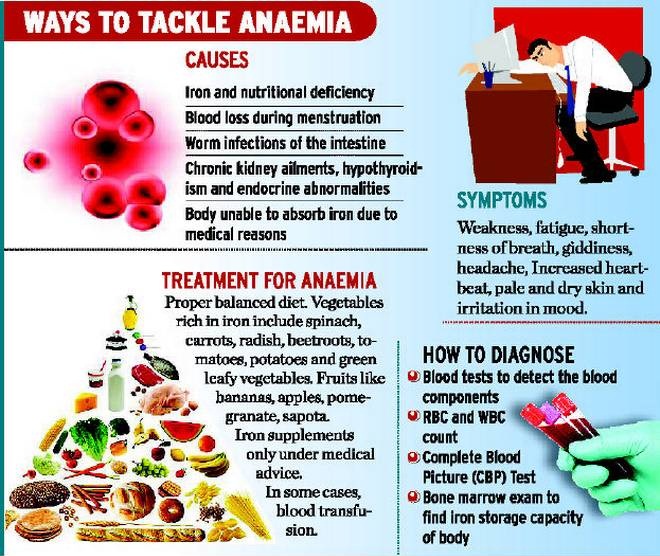Social Justice
Anaemia in Indian Children
- 04 Dec 2019
- 5 min read
Why in News
A paper published in ‘Scientific Reports’ pointed out that about 58.5% of children below five years of age in India are anaemic.
- Over one lakh children were analyzed using the National Family Health Survey (2015-16) data.
- Socio-demographic factors such as the wealth of the family, maternal education, maternal age, type of residence are the main reasons behind the incidence of childhood anaemia.
- Recently, a ‘Lancet Global Health report’ also revealed that 23% of Indian men suffer from anaemia.
Anaemia
- The World Health Organization (WHO) defines anaemia as a condition in which the number of red blood cells or their oxygen-carrying capacity is insufficient to meet physiological needs.
- Iron deficiency is the most common cause of anaemia, although other conditions, such as folate, vitamin B12 and vitamin A deficiencies, chronic inflammation, parasitic infections, and inherited disorders can all cause anaemia.
- In its severe form, it is associated with fatigue, weakness, dizziness and drowsiness. Pregnant women and children are particularly vulnerable.
Key Findings
- Maternal Education
- Maternal education increases the chances of mothers being aware of different health issues and thus taking the correct and appropriate steps towards preventing such issues.
- There exists an inverse relationship between the mother's education and the incidence of childhood anaemia. In other words, as the mother’s education level increases, the tendency of the child to be anaemic decreases significantly.
- Wealth of the Family
- 52.9% of children in rich households were marked anaemic.
- The number was 63.2% in the poorest households.
- This suggests that a large number of children in poor households are anaemic, though the situation in rich households is also not that well.
- Maternal Age
- There exists an inverse relationship between the age of mothers and the incidence of anaemia in children. The children of younger mothers are more anaemic.
- This reveals the powerlessness of mothers in the age group 15-19 years in ensuring that the children get the right food.
- This also reveals the power dimension in the allocation and use of resources in the household.
Indian Programmes Related to Anaemia
- In 2018, the government of India launched Anaemia Mukt Bharat (AMB) as part of the Intensified National Iron Plus Initiative (NIPI) Program for accelerating the annual rate of decline of anaemia from one to three percentage points.
- The target groups for AMB are Children (6-59 months, 5-9 years), Adolescent Girls & Boys (10-19 years), Women of Reproductive Age (15-49 years), Pregnant Women and Lactating Mothers.
- The Ministry of Health and Family Welfare has also launched the Weekly Iron and Folic Acid Supplementation (WIFS) Programme to meet the challenge of high prevalence and incidence of anaemia amongst adolescent girls and boys.
- Other programmes introduced include Integrated Child Development Scheme (ICDS), National Nutritional Anemia Control Program (NNACP), etc to combat anemia.
Way Forward
- A broader health strategy is required to effectively address the issue of anaemia. Also, there is a need to bridge the gap between policy and practice.
- The mother’s health needs to be addressed as anaemia in mothers and premature delivery can also lead to childhood anaemia.
- In addition to the maternal influence on childhood anaemia, paternal and overall household influences need to be considered for a more comprehensive policy framework for intervention at the household level.







